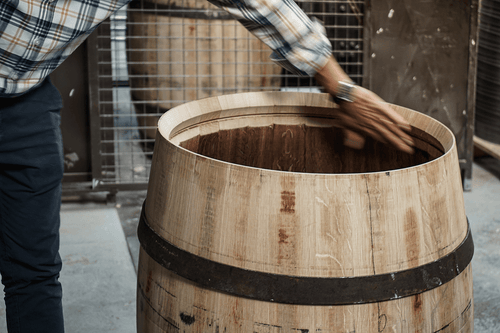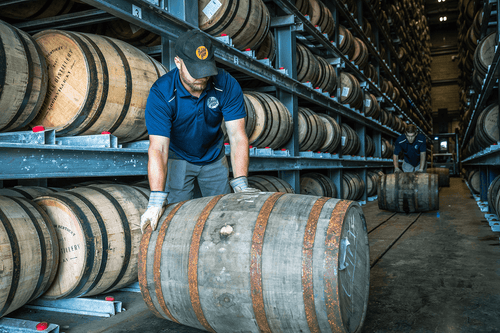Why You'll Never Find The "Smoothest Bourbon"
WHY YOU'LL NEVER FIND
THE SMOOTHEST BOURBON
The term “smooth bourbon” is vague; to some it means light, sweet or low alcohol – and without the loosely interpreted “burning sensation.” To others, it may simply be a way to describe an overall pleasant mouthfeel, or “umami” of sensory experiences. In general, it is mostly nonspecific and relative only to the individual using the term...

Smooth is a term that has long plagued the bourbon industry; with early records of it’s use as an adjective for profiling bourbon dating all the way back to 1743. In fact, the word “smooth” or “smoothest bourbon” is so widely overused that it's lost much of its meaning within the thousands of pages of bourbon forums. Those new to the world of bourbon (and even some seasoned imbibers) often rush to this fallback phrase as a quick and easy fill-in when they don't necessarily know what else to say.
The term “smooth bourbon” is vague; to some it means light, sweet or low alcohol – and without the loosely interpreted “burning sensation.” To others, it may simply be a way to describe an overall pleasant mouthfeel, or “umami” of sensory experiences. In general, it is mostly nonspecific and relative only to the individual using the term.
It is unlikely that the phrase “smooth bourbon” would have achieved such notoriety if it didn't have at least some relevance. Exploring what "smooth" really means when classifying a bourbon will help enlighten your own perceptions and perhaps eliminate it’s validity in the future.
History Of Smooth Bourbon
In an 1897 case held before the New York Supreme Court, a barkeep sued his bourbon supplier for providing four barrels of bourbon whiskey that the barkeep did not deem "smooth," which was a requirement of the contract. In this particular case, the barkeep described smooth bourbon as one "that did not burn, make vomit or drive away."
Fast forward to today and we see many bourbon bloggers and writers use the term “smooth bourbon” in a derogatory manner. What was once deemed a positive trait in bourbon has become a sign of ignorance an inexperience. This contradictive ideology is possibly due to the fact that with the introduction of the internet – there also by default became a common expectation of being educated on the bourbon making process. That, combined with simple herd mentality and widely-accepted industry jargon used by the self-professed bourbon experts, and suddenly “smooth bourbon” is forbidden vernacular.
So, what does all of this mean? In reality, it means nothing. If a person wants to describe a particular bourbon as being “smooth” in place of more more modern and more commonly accepted adjectives, well – that’s America. However, if you like your bourbon to taste a certain way and want to communicate that to others who may be able to point you in the direction of new expressions that match that same profile – you’ll need to expand your bourbon vocabulary a bit.
Distilling a Smooth Bourbon
A bourbon's distillation process, mash bill and age go a long way toward determining its “smoothness.”
If a person reads through the vast archives of bourbon forums and blogs on the internet – it becomes immediately obvious that the smooth attribute described by many new to bourbon is heavily influenced by the mash bill and the distilled proof/barrel entry proof. For the mash bill, bourbons with a higher corn and wheat percentage in their mash bill seem to match what many describe as smooth. Regarding the proof of the spirit before entering the barrel, it is said that the higher the proof the white dog (unaged bourbon) reaches during final distillation, the “lighter” the taste.
The tradeoff of over-filtering and higher proof is a bourbon with far less congeners, which are the flavor-producing compounds in bourbon and the very thing that makes a bourbon unique. Many higher proof bourbons also go through a chill-filtration process which further removes the flavorful congeners. What is left is something that more resembles vodka than fine bourbon.
Going even deeper, during distillation, congeners (in general) become concentrated in the heads or tails of the bourbon whiskey. The heads contain compounds such as methanol, ethyl acetate, and aldehydes with a low boiling point. These compounds are at best undesirable and, at worst, downright toxic. The tails contain little alcohol and a lot of fusel oil, which is also undesirable in the finished bourbon whiskey.
A skilled distiller knows how to make the right "cuts" between the head, heart, and tail of each batch. It's primarily the heart in the middle of that batch that you really want to retain for the best in drinkability. If the distiller makes inaccurate cuts, the finished product may contain more of the head or tail than it should, resulting in an unpleasant drinking experience that's more sharp than what many would describe as smooth.
Identifying the right cuts is no small task, however. A distiller who can artfully claim only the heart may find their finished bourbon somewhat lacking. For many bourbon aficionados, there is such a thing as “too smooth.” Including a small portion of the head or tail can produce a more distinctive flavor palate and distinction between various flavor notes.
The heads and tails can act as a kind of flavoring, adding depth and complexity to the whiskey when included in the right proportions. Determining what those proportions are is at the heart of the fine art of distilling great bourbon. Basically, it’s a combination of science, skill and a little magic.
The final aspect is sugar. The more sugar, the “smoother” a bourbon might taste. The char level of the barrel a bourbon enters can increase or decrease natural sweetness during the aging process. When a barrel is toasted and charred the barrels can pull even more naturally occurring sugars and notes of warm vanilla (called vanillin) from the new white American oak barrel. This allows for the same smooth factor resulting from a higher proof bourbon but with a lower barrel entry proof while also retaining coveted congeners. More congeners, more flavors and more depth and complexity. To put it simply, a better bourbon.
Beyond Smooth: Other Ways To Describe Bourbon
If you are interested in bourbon, and want to go further down the “rabbit hole” - desiring to converse more intelligently about it helps to have a handful of other terms in your pocket that you can use in place of “smooth.”
Instead of addressing how easily the bourbon goes down or how it does not burn, try assessing its aromas. Does the bourbon have a chocolaty smell, a hint of caramel, or a robust oak character? When you sip the bourbon, pay attention to what you taste before the drink goes down. Take a moment to savor the notes that dance on your tongue. Some bourbons have a fruity flavor reminiscent of berries, while others make you think of vanilla, tobacco or leather. Notes like honey, cinnamon, and marzipan are other tastes that you're likely to encounter with a well-aged bourbon whiskey.
Finally, assess the finish. This is the flavor that you're left with after you've swallowed. Does it fade quickly or linger? Do you find the finish warm and creamy or crisp and clean? Some bourbons are dry while others feel more refreshing. Diving deeper into these characteristics will help you explore the finer complexities of bourbon without resorting to more generic phrases like "smooth."
If it is a certain mouthfeel you are after, describe it with lots of detail. Instead of “smooth bourbon” or “smoothest bourbon” you might instead say “this bourbon has a silky texture and coats the mouth well.” Or perhaps “I like this bourbon because it has a creaminess and viscous quality when swirled in the mouth; one which seems to linger long after it is swallowed.”
There really is no wrong way to describe what a glass of bourbon “feels” like, however, the more adjectives you can offer, the better bourbon experts will be equipped to direct you to similar expressions and brands. What is described as a “smooth bourbon” to one may be completely different for another. However, using a diverse spectrum of adjectives can paint a clear and accurate picture of what it is you find appealing about your favorite expression.






















